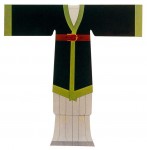Introduction of Ethnic Minority Styles
In as early as the Warring States Period, the sixth emperor of Zhao already  realized that although the Zhao army had better weapons, the long robes worn by generals and warriors were too cumbersome for an army, especially when they had to drag their armors and supplies around. They had tens of thousands of soldiers, but few riders flexible to make a quick attack. He went against all objections and advocated for change towards the Hu or western minority clothing style of the nomadic riders. The Zhao soldiers wore shorter robes and trousers and soon became a better army. Economic development followed.
realized that although the Zhao army had better weapons, the long robes worn by generals and warriors were too cumbersome for an army, especially when they had to drag their armors and supplies around. They had tens of thousands of soldiers, but few riders flexible to make a quick attack. He went against all objections and advocated for change towards the Hu or western minority clothing style of the nomadic riders. The Zhao soldiers wore shorter robes and trousers and soon became a better army. Economic development followed.
Moreover, this style that was once frowned upon and rejected became the daily wear of the common folks by Wei, Jin and Southern and Western Dynasties in the central plains. One reason for this change, unfortunately, was the frequent migration of the people to run away from the incessant wars and chaos. This process also helped the exchange of garment culture. Kuzhe and liangdang are the typical “Hu” or minority wear of that time. It is not hard to see that both styles are fit for riding and for life in the cold climate. The so-called kuzhe is a style with separate upper and lower garments. The upper garment looks like a short robe with wide sleeves, a central China adaptation to the original narrow sleeves fit for riding and herding animals. What also changed was the closure of the robe, which moved from left to right. Interestingly, people of central China called the northwestern people “people with left closure.” The robes at this time were shortened significantly, and varied in style. Historical materials show a number of styles of these upper garments in Wei, Jin, Southern and Northern Dynasties, which had left, right and middle closure, or even swallowtails at the front hem. A set of these garments makes the wearer sharp and agile, as is frequently seen in clay burial figurines in the Southern Dynasty.
The lower garment of the kuzhe is a pair of trousers with closed crotch. Initially these trousers were close fitting, showing off slender legs that could freely move around. When this style appeared in central China, especially when some officials wore them in court, the conservatives questioned the appropriateness of the two thin legs that cried out rebellion against the loose fitting traditional ceremonial wear. Widening the legs was a compromise, so that the pants still appeared similar to the traditional robe. When walking about, these pants were more flexible and convenient than the robe. To avoid being caught in thorns or dragged in mud, someone came up with a brilliant idea of lifting the trouser legs and tying them up just below knee-level. This kind of pants can be frequently seen in the Southern Dynasty’s burial figurines and brick paintings. In appearance, they are quite similar to the bell bottomed pants in the modern days, but in reality, they are only similar in profile, not in construction.
Liangdang or double-layered suit is another style typical of this period, and it came from the northwest into central China. It was no more than a vest, which can be seen in many burial pieces of that time. Judging from clay figurines and wall paintings in tombs, the vest was in two separate pieces fastened on the shoulders and under the arms. There were also liangdangs worn inside in materials of leather or cotton, lined or unlined, close or loose fitting. The name has changed over the years but the style remained. The above mention garments were all the rage at that time for both women and men. The separate piece style has always been the prototype of the Chinese people, but modifications were made due to the exchange and fusion of different garment cultures.